A fresh narrative is unfolding in the world of cryptocurrencies: the chase for a Bitcoin Exchange-Traded Fund (ETF). This innovative avenue of investment harbors the potential to redefine the way conventional investors interact with the virtual domain. Come along as we dissect the multifaceted nature of the Bitcoin ETF, delving into its repercussions, advantages, and obstacles, and charting a path through the continuously shifting financial landscape.
The Bitcoin ETF, an Exchange-Traded Fund, is an investment tool mirroring the price fluctuations of a specific asset or commodity. In the case of the Bitcoin ETF, that asset is none other than Bitcoin itself. Investors can purchase and sell shares of this ETF on stock exchanges and brokerage accounts. Unlike direct Bitcoin ownership, the ETF’s custody is overseen by its manager. This innovative approach enables investors to ride Bitcoin’s price shifts without wrestling with self-custody intricacies or maneuvering within cryptocurrency exchanges.
Several Bitcoin ETF types exist, each bringing a distinct approach to accessing the digital asset world. Among them, futures ETFs have gained regulatory approval, although they don’t offer direct Bitcoin ownership. Instead, they track futures contracts predicting Bitcoin’s future prices, introducing a speculative element.
While futures ETFs have progressed, the quest for a spot Bitcoin ETF has been marked by applications and rejections. The aim is to create an ETF reflecting Bitcoin’s current price directly. Yet, this journey has encountered hurdles, including investor protection and market manipulation concerns. Despite repeated setbacks, companies remain steadfast in their pursuit of regulatory approval, motivated by the potential to unlock a new realm of investment possibilities.
Bitcoin trusts and spot Bitcoin ETFs both offer Bitcoin exposure without necessitating direct digital asset ownership. However, they operate via distinct structures, pricing methods, and levels of regulatory oversight. Bitcoin trusts, exemplified by MicroStrategy Bitcoin Trust (MSTR) and Grayscale Bitcoin Trust (GBTC), are private, closed-end funds invested exclusively in Bitcoin. They trade at premiums or discounts to the underlying asset’s value, providing exposure without actual ownership. On the other hand, spot Bitcoin ETFs are open-end funds tradable on major exchanges, allowing investors to purchase and sell shares throughout the trading day, aligned with Bitcoin’s spot price. ETFs permit share creation and redemption, ensuring a closer link with the asset’s value.
The history of spot Bitcoin ETF applications tells a story of persistence and evolving dynamics. Noteworthy proposals like the Winklevoss Bitcoin Trust and VanEck SolidX Bitcoin Trust have faced regulatory scrutiny and multiple rejections. Nevertheless, the landscape is shifting as financial giants such as BlackRock enter the arena, introducing new provisions like surveillance-sharing agreements to thwart manipulation.
A successful spot Bitcoin ETF approval carries an array of implications for the cryptocurrency realm. It could catalyze increased legitimacy, liquidity, and adoption of Bitcoin among traditional investors. Moreover, the ETF’s inception might stimulate demand and appreciation of Bitcoin’s value, akin to the influence observed with gold ETFs. However, challenges encompass concerns of market manipulation, regulatory dependencies, and potential displacement of direct Bitcoin ownership.
The journey towards a spot Bitcoin ETF approval involves timelines, regulatory considerations, and unprecedented anticipation. The future looks promising, with analysts projecting heightened probabilities of approval, supported by robust application histories and evolving regulations.
The potential nod to a Bitcoin spot ETF unveils both opportunities and challenges, carving a fresh trajectory for traditional investors to venture into the cryptocurrency sphere. As this pivotal moment approaches, the financial world stands on the cusp of embracing the transformational potency of Bitcoin through a regulated and accessible investment pathway. The countdown persists, and the spotlight on the journey to regulatory affirmation intensifies with each passing day.


